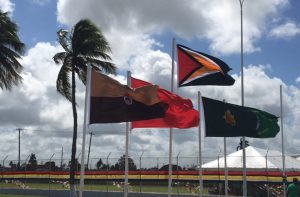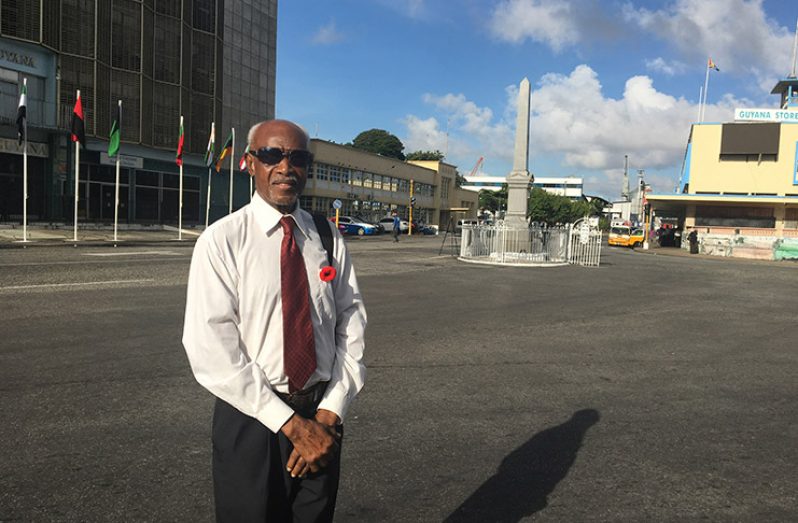By Francis Quamina Farrier
TODAY, the second Sunday of November, is observed in many countries around the world as Remembrance Day — a day set aside to remember and pay homage to the millions of brave military men and women, especially those who served with distinction and more so, those who paid the ultimate price with their very lives, defending their countries and the freedom of their fellow citizens.
It is known that thousands of men from British Guiana served in both the First and Second World Wars with the West India Regiment, as well as with British Forces in the United Kingdom. The author of “To Sir, with Love,” E.R. Braithwaite and the international movie star and entertainer, Cy Grant, were among those who served in the Royal Air Force in World War ll. During the period I produced my Radio Programme Series, The Eighty Plus Club — 1980s and 1990s — I was fortunate to have had the opportunity to interview three veterans who served in World War One — 1914-1918. The longest-surviving Guyanese World War One Veteran was Gershom Browne, who lived at Bagotville on the West Bank of Demerara. He was a regular special feature at the Cenotaph in Georgetown at the annual Remembrance Day Observances, where he would lay a wreath every year on that special day. Many who saw that very elderly gentleman slowly walking to the Cenotaph with a wreath in his hands could hardly imagine that 80 years earlier he fought the Turks and other enemy forces in fierce battles in North Africa and also in the Middle East.
Gershom Browne was a man of valor. He informed me that he was a descendant of enslaved Africans brought to this land from Sierra Leone in West Africa and many of his immediate ancestors, who had been attached to Bagotville for generations, spoke one of the African languages. When called upon as a young man, he readily enlisted and fought for King and Country. As a civilian back in British Guiana after the war, he served as the Village Chairman of Bagotville for many years, building that Number One Canal West Bank Demerara community and settling some disputes. Even as a retired public servant I witnessed Gershom Browne settle a dispute between two residents of Bagotville, who had sought his advice. I was visiting him at his home at the time when the two neighbours turned up. They had decided that they would abide by whatever decision the retired village chairman had made, and they did accept his ruling. It was all quickly and quietly done. I wondered why they had decided to take their case to him, since he was already retired and 95-year-old at the time. Could it have been that they trusted him more than the then-current functionary? Another amazing thing about that World War One soldier, was that he rode his bicycle almost to his 100th birthday. “Old soldiers never die”; he simply passed away at age 102.
ALSO REMEMBERING OUR GDF VETERANS

It is no doubt that had it not been for the brave soldiers of the Guyana Defence Force, Guyana would not be the size it is now. There are very few Guyanese of today who think of the Rupununi Revolt which commenced on January 2, 1969. On that fateful day, a group of wealthy ranchers commenced a bloody revolt against the Government of Guyana, to sever the Rupununi from the rest of Guyana and make it a separate republic. Their first murderous acts were to shoot and kill five policemen who were stationed at the Lethem Police Station. A Guyana Airways Dakota aeroplane was at the time loading beef from the abattoir nearby. On seeing the unfolding violence, the pilot, Capt. Ronald Da Silva, closed the door of the plane and took off from Lethem for Georgetown.
Learning of the revolt, the Guyana Defence Force high command at the Camp Ayanganna headquarters in the city dispatched a Dakota aeroplane with GDF soldiers on board. It flew into the Rupununi from Atkinson Field (now Timehri) just after mid-day. Even before the sun had set that very day, January 2, 1969, a second aeroplane from Georgetown landed in the North Rupununi; on board were Lt. Joseph Singh and about 15 soldiers under his command. The GDF ranks were welcomed with hostile gunfire from the rebels. The GDF ranks returned their own firepower which resulted in the hasty retreat of the rebels. Realising that they were no match for the well-trained, professional GDF ranks, the revolters fled to neighbouring Brazil and Venezuela. The Guyana Defence Force had won. The Rupununi was saved and remained Guyanese territory.
Another incident in which the Guyana Defence Force had to defend the territorial integrity of Guyana, was what became known as “The New River Triangle.” The neighbouring Dutch-speaking country Suriname had laid claim to that large south-eastern section of Guyana and had moved their military personnel to the location. Some of the GDF ranks who saw fierce fighting between the Guyanese and the Surinamese military include Hartley Liverpool, Marcus Munroe, Asad Ishoof, Martin Nascimento, Ramcharitar and Clairmont Griffith, among others. Clairmonte Griffith told me of lying on the floor of a Twin Otter aircraft in which GDF ranks flew to Camp Jaguar, and successfully engaged the Suriname military in a bitter confrontation. Recorded on page 81 of his book, “Foundation of the Guyana Defence Force,” decorated GDF soldier of valor Hartley Liverpool states: “Profoundly, we accomplished an effective and triumphant mission. The Dutch flag was lowered and the Golden Arrowhead was raised in victory.” Sometime later, I myself as a journalist was taken into Camp Jaguar where I reported the on-going progress by the Guyana Defence Force in that far-flung area of the Cooperative Republic of Guyana, for the VCT Evening News. I have always spoken of the massive-sized plantains and other crops which I saw at Camp Jaguar. The Guyana Defence Force must be recognised for keeping Guyana its original 83,000 square miles in size in the face of attempts by international land-grabbers.



.jpg)








